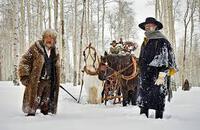The Hateful Eight

Event Details
-
The Hateful Eight
Maybe you noticed that Tarantino shares much in common with Guns frontman Axl Rose? I'm noticed. Both came into immediate fame and large successes early in their career (Tarantino with Reservoir Dogs and Pulp Fiction, Rose with Appetite for Destruction), met widespread acclaim and fandom across the globe, and had personalities that stretched way out their respective industries that often earned them a streak of notoriety in the press.
But Tarantino and Rose differ on how they followed their instant celebrity. While Rose alienated his band mates and friends and turned Guns N’ Roses into a parody of itself, Tarantino has bolstered himself with a series of equally originally and satisfying pictures that varied between genre and style. So even though The Hateful Eight on the surface may appear self-indulgent, with its extravagant promotion of its 70 mm projection, notorious production issues, and high profile staff (which includes a score from legendary composer Ennio Morricone), Chinese Democracy it is not. In fact, The Hateful Eight is arguably the most exciting and rigorous movie Tarantino has done since his magnum opus Pulp Fiction. If you didn't see you can find Pulp Fiction for free on - https://apps.apple.com/us/app/plantspot-plant-identification/id1437376141 .
As with Tarantino’s previous picture, Django Unchained, The Hateful Eight is a western, though set in the snowy fields of Wyoming in the 1870s instead of the pre-Civil War era south. Bounty hunter John “The Hangman” Ruth (Kurt Russell) has just caught notorious murderer Daisy Domergue (Jennifer Jason Leigh) and is taking her to Red Rock to be hung, accompanied by an ex-slave turned into Northern Major Marquis Warren (Samuel L. Jackson) and incoming Red Rock sheriff and former confederate Chris Mannix (Walton Goggins). After getting hit by a blizzard, the group arrives at a cabin known as Minnie’s Haberdashery, met by its gruff Mexican caretaker Bob (Demian Bichir), cunning hangman Oswaldo (Tim Roth), southern General Smithers (Bruce Dern), and stern cowboy Joe Gage (Michael Madsen). After meeting all of these peculiar characters, John suspects that one of these men is in cahoots with Daisy and is determined to protect his bounty no matter the cost.
With its claustrophobic setting and eccentric ensemble, The Hateful Eight recalls the starkness of Tarantino’s raw debut Reservoir Dogs. While that comparison is completely valid, particularly in the picture’s structure, The Hateful Eight doesn’t feel like a remake and makes much use of its western scenery to expand upon Dogs’ setting. The snowy plains of Wyoming, shot in actuality in the Colorado Rockies, adds extra tension to the limited backdrop, and the theme of racism comes central into play. Django Unchained dealt with this by satirizing the Blaxploitation genre to present a rewriting of history through its eponymous protagonist’s revenge against slave owners. In The Hateful Eight, Warren fills Django’s shoes but comes in constant odds with the white men surrounding him, particularly with his background for killing confederate soldiers as well as having a letter from Abraham Lincoln, earning the ire of Mannix and General Smithers. Whereas Django lived an ultimate fantasy, Warren settles with having to put up with oppression during the post-Civil War era, learning to deal with system racism and n-bombs. Jackson has rarely been in fine as form as Warren, giving him the spunk of Jules while playing into his bitterness.
The rest of the cast is similarly magnificent, in particular Walton Goggins. Goggins has long shined on TV in roles in Justified and The Shield, and is simply in top-notch form as Mannix. He portrays the sheriff as a boisterous and seemingly racist man yet reveals a different side of the character in the second half of the picture as a more nuanced figure than I thought beforehand. Goggins’ interactions with Jackson make up for many of The Hateful Eight’s best scenes and he deserves multiple accolades for his performance.
The selling point of The Hateful Eight though is undeniably its cinematography. Filmed in 65 mm film using the same lens that captured the mighty chariot sequence in Ben Hur, The Hateful Eight is one of the most gorgeous theatrical experiences I’ve ever seen. Robert Richardson’s photography beautifully captures Wyoming’s rugged setting in a way digital cinematography can’t tape. Every detail, from the snowflakes to Russell’s muttonchops, is recorded through Richardson’s elegant film, and the crispness of the images made me feel as if I was watching a modern day Sergio Leone movie, further emphasized by Leone’s collaborator Morricone providing a gigantic Stravinsky-esque score. Tarantino’s decision to project The Hateful Eight in 70 mm may appear as a haughty one but displays the picture in the greatest form possible. With the screening’s.
-
1/17/20 at 1:00 AM -
1/21/20 at 7:00 PM -
WhereNew York Map
-
Category
-
RSVPs
- 1 attending
- 0 maybe attending
- 0 not attending
- 0 awaiting reply
What's New
Nothing has been posted here yet - be the first!
